Gross Domestic Product (GDP) by Income and Expenditure
On November 7, 2024 Statistics Canada released preliminary Provincial Gross Domestic Product (GDP) by Income and Expenditure data for 2023 and revisions for 2021 and 2022.
Real GDP1 at Market Prices (Income and Expenditure Accounts)
Economic activity slowed in Canada in 2023, as Canada’s real gross domestic product (GDP) grew 1.5 per cent, after an increase of 4.2 per cent in 2022. Growth in real GDP was driven by exports and household spending on services. Real GDP rose in nine provinces and two territo-ries, with Newfoundland and Labrador (-2.6 per cent) and the Northwest Territories (-0.5 per cent) recording declines. Among the provinces, British Columbia (2.4 per cent), Saskatchewan (2.3 per cent) and Alberta (2.3 per cent) had the largest annual increases in GDP.
Prince Edward Island
The PEI GDP at market prices in current dollars was valued at $9.9 billion in 2023. The statis-tics show that the Prince Edward Island economy expanded by 2.2 per cent in chained 2017 dollars. This was the fourth largest increase among provinces.
By this measure, the revised data shows the PEI economy grew by 7.8 per cent in 2021, revised down from 8.4 per cent, and grew by 4.4 per cent in 2022, up from 2.9 per cent.
Diagram 1 illustrates provincial economic growth from 2019 to 2023 in chained 2017 dollars.
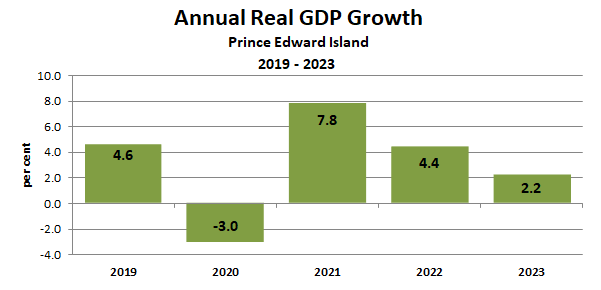
As Table 1 indicates, the national economy expanded by 1.5 per cent in chained 2017 dollars in 2023, following a 4.2 per cent increase in 2022. Nunavut saw the highest growth among provinces and territories in 2023 with an increase of 3.8 per cent, followed by British Columbia at 3.8 per cent and Saskatchewan and Alberta at 2.3 per cent. Real GDP increased in all provinces and territories in 2023, with the exception of Newfoundland and Labrador and the Northwest Territories.
TABLE 1 - REAL GDP CHANGE, CANADA, PROVINCES AND TERRITORIES, 2019 - 2023
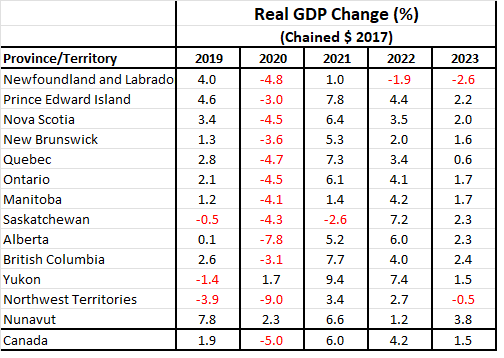
Growth in Prince Edward Island was led by exports of 4.4 per cent, particularly service exports to other countries, which increased by 17.2 per cent. This was only partially offset by an increase in imports2 of 1.6 per cent.
Household spending also contributed significantly to growth, with an increase of 2.8 per cent in 2023, following a similar increase in 2022. The increase was driven mainly by a 4.1 per cent increase in spending on services.
Table 2 shows PEI’s expenditure based real GDP in chained 2017 dollars from 2019 to 2023.
TABLE 2 - REAL GDP, EXPENDITURE BASED (CHAINED 2017 DOLLARS), PRINCE EDWARD ISLAND, 2023
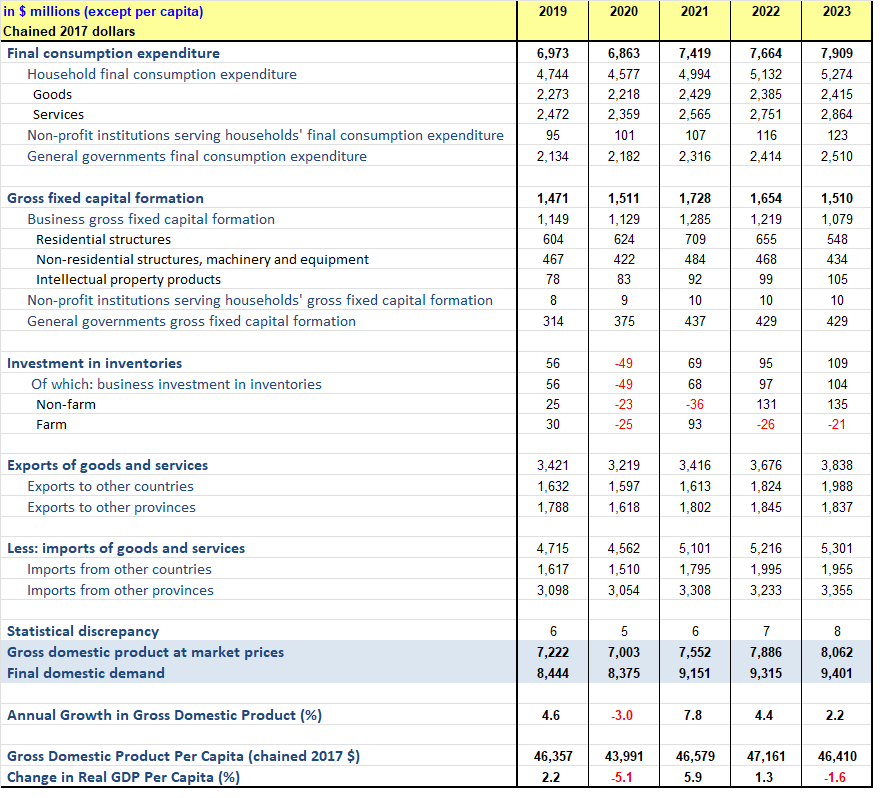
Table 3 shows contributions to change3 in real GDP for 2023. Final consumption expenditure, the largest component of GDP, contributed 3.0 percentage points. Services added 1.4 percentage points to the increase of the final consumption expenditure component, while general governments final consumption expenditure added 1.2 percentage points. Gross fixed capital formation deducted 2.0 percentage points. An increase in investment in inventories increased GDP growth by 0.2 percentage points in 2023. Exports of goods and services added 2.0 percentage points while imports of goods and services2 also increased, deducting 1.1 percentage points from GDP growth, for a total net gain of 0.9 percentage points for international and interprovincial trade.
TABLE 3 - REAL GDP, EXPENDITURE BASED, CONTRIBUTIONS TO PERCENT CHANGE, PRINCE EDWARD ISLAND, 2023
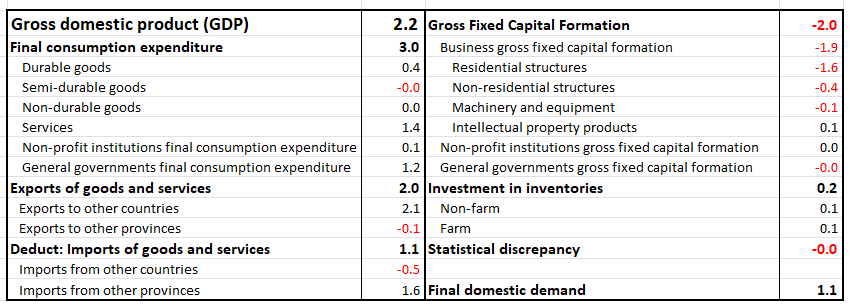
Nominal GDP
Growth in nominal GDP4 in 2023 exceeded growth in real GDP in most provinces and territories, except Saskatchewan and Alberta where nominal growth was negative and Newfoundland and Labrador where nominal growth was further negative than real growth. The national GDP implicit price index rose 1.4 per cent, reflecting significantly moderated price increases compared to 2022.
PEI's GDP implicit price index5 rose 2.6 per cent in 2023, following growth of 5.8 per cent in 2022 and 6.5 per cent in 2021. Consequently, nominal GDP increased 4.9 per cent, following nominal GDP growth of 10.4 per cent in 2022 and 14.8 per cent in 2021. By comparison, national nominal GDP increased 2.9 per cent, with Nunavut recording the largest year-over-year increase in 2023 at 11.7 per cent. Table 4 shows the change in nominal GDP for Canada, the provinces and territories.
TABLE 4 - NOMINAL GDP CHANGE, CANADA, PROVINCES AND TERRITORIES, 2019 - 2023
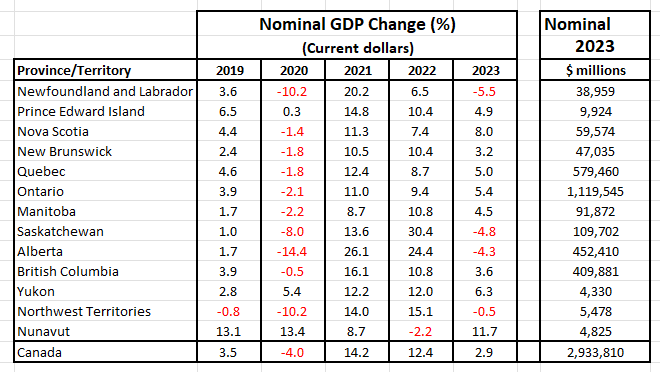
Notes:
1 Real gross domestic product (GDP) is GDP given in constant prices and refers to the volume level of GDP. Constant price estimates of GDP are obtained by expressing values of all goods and services produced in a given year, expressed in terms of a base period.
2 Imports are a deduction from GDP. An increase in imports results in a negative contribution to change.
3 Contributions to percent change are presented as percentage points.
4 Nominal gross domestic product (GDP) is GDP given in current prices, without adjustment for inflation.
5 The GDP implicit price index reflects the overall price of domestically produced goods and services.
Source: Statistics Canada.
Table 36-10-0222-01 Gross domestic product, expenditure-based, provincial and territorial, annual (x 1,000,000)
Table 36-10-0223-01 Implicit price indexes, gross domestic product, provincial and territorial
released November 8, 2023.
Related downloads for this release:
Annual GDP By Income and Expenditure report (246 KB)